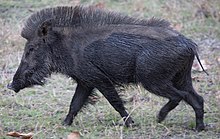Post by dinosauria101 on Sept 29, 2019 14:29:51 GMT 5
Indian Leopard - Panthera pardus fusca
The Indian leopard (Panthera pardus fusca) is a leopard subspecies widely distributed on the Indian subcontinent. The species Panthera pardus is listed as Vulnerable on the IUCN Red List because populations have declined following habitat loss and fragmentation, poaching for the illegal trade of skins and body parts, and persecution due to conflict situations.[1] The Indian leopard is one of the big cats occurring on the Indian subcontinent, apart from the Asiatic lion, Bengal tiger, snow leopard and clouded leopard. Male Indian leopards grow to between 127 cm (4 ft 2 in) and 142 cm (4 ft 8 in) in body size with a 76 cm (2 ft 6 in) to 91 cm (3 ft) long tail and weigh between 50 and 77 kg (110 and 170 lb). Females are smaller, growing to between 104 cm (3 ft 5 in) and 117 cm (3 ft 10 in) in body size with a 76 cm (2 ft 6 in) to 87.6 cm (2 ft 10.5 in) long tail, and weigh between 64 and 75 lb (29 and 34 kg). Sexually dimorphic, males are larger and heavier than females.[12] The largest wild individual appears to have been a male man-eater that was shot in the Dhadhol area of Bilaspur district, Himachal Pradesh in 2016. It reportedly measured 262 cm (8 ft 7 in) from head to tail, 86 cm (34 in) at the shoulder, and weighed 71 kg (157 lb).

upload.wikimedia.org/wikipedia/commons/thumb/0/06/Leopard_Male_Nagarhole.jpg/1024px-Leopard_Male_Nagarhole.jpg
Indian boar - Sus scrofa cristatus
The Indian boar (Sus scrofa cristatus), also known as the Andamanese pig or Moupin pig[2] is a subspecies of wild boar native to India, Nepal, Burma, western Thailand and Sri Lanka. The Indian boar differs from its European counterpart by its large mane which runs in a crest along its back from its head to lower body, larger, more sharply featured and straighter skull, its smaller, sharper ears and overall lighter build.[3] It is taller and more sparsely haired than the European form, though its back bristles are much more developed.[2] The tail is also more tufted, and the cheeks hairier.[4] Adults measure from 83.82 to 91.44 cm (33.00 to 36.00 in) in shoulder height (with one specimen in Bengal having reached 38 inches) and five feet in body length. Weight ranges from 90.72 to 136.08 kg (200.0 to 300.0 lb).

upload.wikimedia.org/wikipedia/commons/thumb/0/01/Sus_scrofa_cristatus.jpg/220px-Sus_scrofa_cristatus.jpg
Credit to Wikipedia
The Indian leopard (Panthera pardus fusca) is a leopard subspecies widely distributed on the Indian subcontinent. The species Panthera pardus is listed as Vulnerable on the IUCN Red List because populations have declined following habitat loss and fragmentation, poaching for the illegal trade of skins and body parts, and persecution due to conflict situations.[1] The Indian leopard is one of the big cats occurring on the Indian subcontinent, apart from the Asiatic lion, Bengal tiger, snow leopard and clouded leopard. Male Indian leopards grow to between 127 cm (4 ft 2 in) and 142 cm (4 ft 8 in) in body size with a 76 cm (2 ft 6 in) to 91 cm (3 ft) long tail and weigh between 50 and 77 kg (110 and 170 lb). Females are smaller, growing to between 104 cm (3 ft 5 in) and 117 cm (3 ft 10 in) in body size with a 76 cm (2 ft 6 in) to 87.6 cm (2 ft 10.5 in) long tail, and weigh between 64 and 75 lb (29 and 34 kg). Sexually dimorphic, males are larger and heavier than females.[12] The largest wild individual appears to have been a male man-eater that was shot in the Dhadhol area of Bilaspur district, Himachal Pradesh in 2016. It reportedly measured 262 cm (8 ft 7 in) from head to tail, 86 cm (34 in) at the shoulder, and weighed 71 kg (157 lb).

upload.wikimedia.org/wikipedia/commons/thumb/0/06/Leopard_Male_Nagarhole.jpg/1024px-Leopard_Male_Nagarhole.jpg
Indian boar - Sus scrofa cristatus
The Indian boar (Sus scrofa cristatus), also known as the Andamanese pig or Moupin pig[2] is a subspecies of wild boar native to India, Nepal, Burma, western Thailand and Sri Lanka. The Indian boar differs from its European counterpart by its large mane which runs in a crest along its back from its head to lower body, larger, more sharply featured and straighter skull, its smaller, sharper ears and overall lighter build.[3] It is taller and more sparsely haired than the European form, though its back bristles are much more developed.[2] The tail is also more tufted, and the cheeks hairier.[4] Adults measure from 83.82 to 91.44 cm (33.00 to 36.00 in) in shoulder height (with one specimen in Bengal having reached 38 inches) and five feet in body length. Weight ranges from 90.72 to 136.08 kg (200.0 to 300.0 lb).

upload.wikimedia.org/wikipedia/commons/thumb/0/01/Sus_scrofa_cristatus.jpg/220px-Sus_scrofa_cristatus.jpg
Credit to Wikipedia



